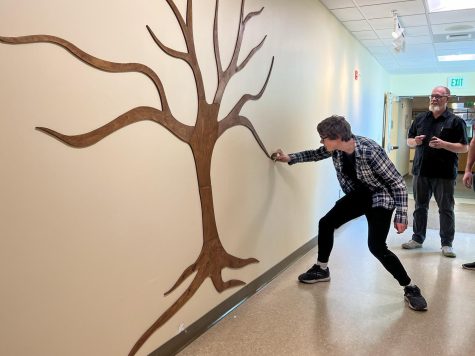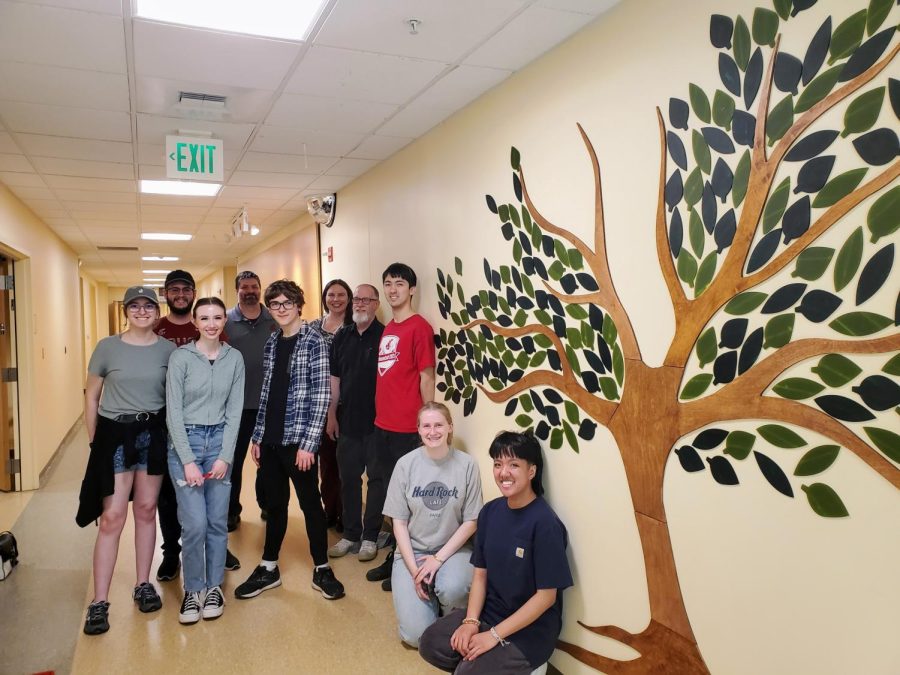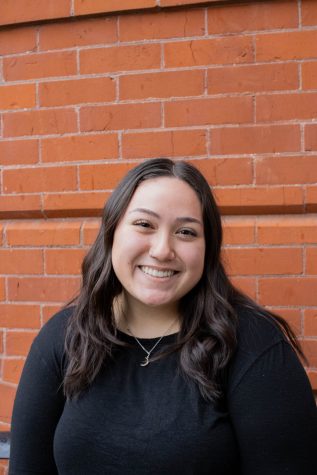Pullman Regional Hospital and WSU partner to create memorial project
The Tree of Remembrance will honor patients and staff who have passed on
COURTESY OF PULLMAN REGIONAL HOSPITAL
Group photo at Pullman Regional Hospital in front of the Tree of Remembrance mural, Saturday, April 29, 2023.
May 2, 2023
A small group of WSU students and Pullman Regional Hospital staff members gathered at the hospital Saturday morning to install a Tree of Remembrance memorial to honor hospital patients and staff who have passed away since the construction of the hospital in 2004.
Composed of 415 individual leaves, this tree has special meaning to the hospital staff who are a part of the comfort care team, who take care of patients at the end of life, said Anna Engle, registered nurse and the Palliative Care Coordinator for Pullman Regional Hospital.
“Our staff puts a lot of their energy and thought and care into patients at the end of life and so I think this is a nice way to help staff remember the work they’ve done in the past,” she said. “And it also gives back to the community because when they’re here they can see that we’re still honoring and remembering.”
As a public community hospital, this was a special partnership between WSU and Pullman Regional to help create the tribute to hospital staff and the community at large, said Alison Weigley, Pullman Regional Hospital’s director of external relations.
Each component of the tree has a specific meaning: the leaves represent adult patients, the butterflies represent pediatric patients and hospital staff members are represented with stones at the bottom of the tree as the “foundation that helps care for all these patients that have been here,” Engle said.

In June, Engle said they hope to add names of late patients and staff members to the leaves.
Chris Lavoie, Experiential Learning Designer and Spark Operations Administrator, and Jon Manwaring, Information Systems Manager, Academic Outreach and Innovation, helped facilitate this project with WSU students.
“We always like to find projects that are meaningful for the students so they can apply all the skills that they’ve learned in the design studio, are real on the project,” Manwaring said. “I feel like it’s also special because it’s an opportunity for the university to meet the community in a specific space that’s important. It’s not a trivial thing here.”
The entire tree was essentially mostly hand-built with lasers in the WSU Design Studio and was designed and carried out by the students working on the project. In total, the students spent over 200 hours working on the project over the last year, Lavoie said.
The materials for the project were provided by Pullman Regional Hospital and were built in the WSU Design Studio, which is funded by the student technology fee paid by student tuition.
There was a call-out to WSU students who wanted to be involved to create a design to send to Pullman Regional Hospital, which was the first step in narrowing down the final design, Lavoie said.
Of all the design submissions, it was Lain Bundalian’s final design that was selected, something they did not expect.
“What I put on the screen is going up on the wall, which is really a surreal experience, but just very rewarding,” Bundalian, a Digital, Technology and Culture major, said.
Not only was this project a great way to experience what work after school will be like, but it went beyond just an assignment for class, it was a service for a meaningful project, they said.
“I’m just proud of ourselves as a collective team for coming together. And there’s so many different elements that went into it like pricing the materials or communicating with the staff here and our staff and, of course, the design … I found that to be really interesting, seeing it all come together in that way,” Bundalian said.
“Pullman’s a really special place. It’s very community-oriented, and so we exist to serve our community,” Weigley said. “We exist to help the people here thrive.”
















